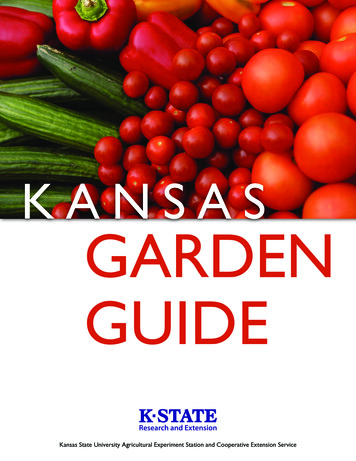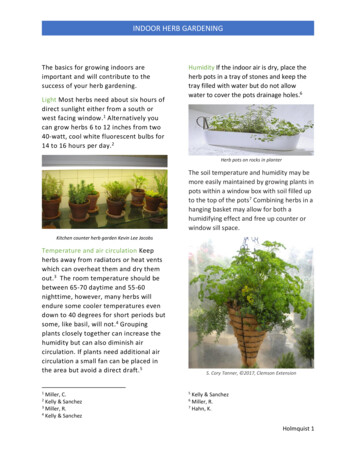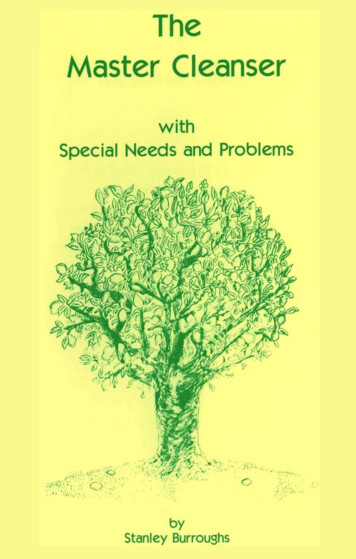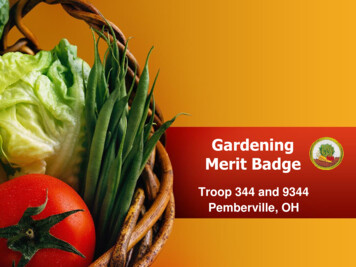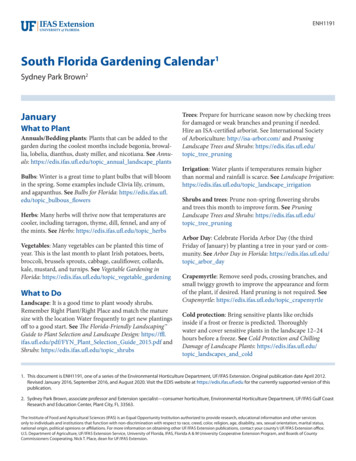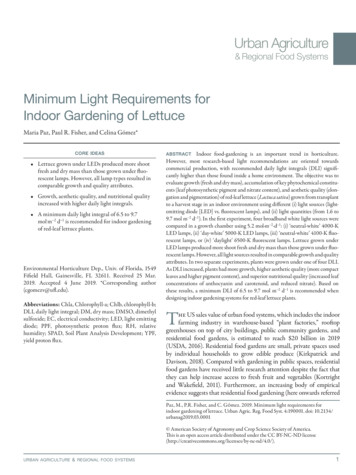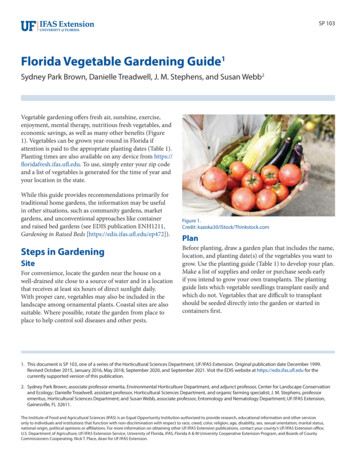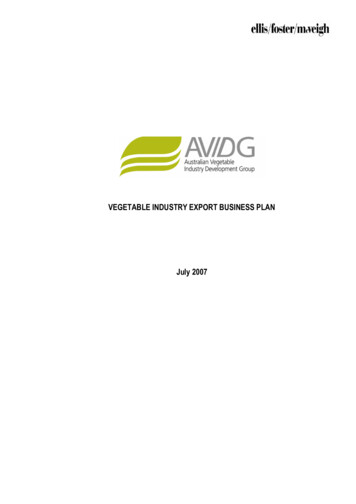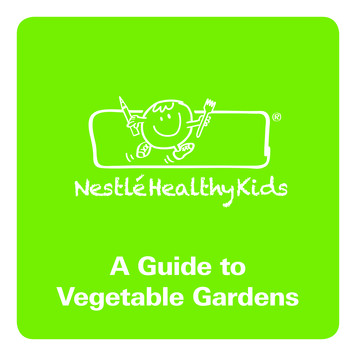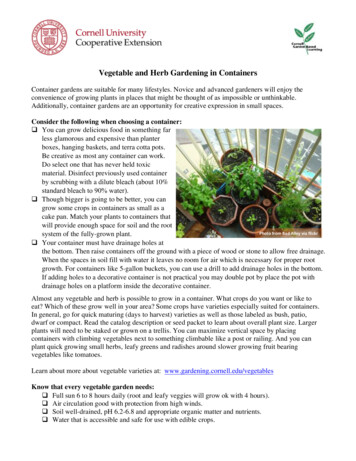
Transcription
Vegetable and Herb Gardening in ContainersContainer gardens are suitable for many lifestyles. Novice and advanced gardeners will enjoy theconvenience of growing plants in places that might be thought of as impossible or unthinkable.Additionally, container gardens are an opportunity for creative expression in small spaces.Consider the following when choosing a container:q You can grow delicious food in something farless glamorous and expensive than planterboxes, hanging baskets, and terra cotta pots.Be creative as most any container can work.Do select one that has never held toxicmaterial. Disinfect previously used containerby scrubbing with a dilute bleach (about 10%standard bleach to 90% water).q Though bigger is going to be better, you cangrow some crops in containers as small as acake pan. Match your plants to containers thatwill provide enough space for soil and the rootPhoto from Bad Alley via flickrsystem of the fully-grown plant.q Your container must have drainage holes atthe bottom. Then raise containers off the ground with a piece of wood or stone to allow free drainage.When the spaces in soil fill with water it leaves no room for air which is necessary for proper rootgrowth. For containers like 5-gallon buckets, you can use a drill to add drainage holes in the bottom.If adding holes to a decorative container is not practical you may double pot by place the pot withdrainage holes on a platform inside the decorative container.Almost any vegetable and herb is possible to grow in a container. What crops do you want or like toeat? Which of these grow well in your area? Some crops have varieties especially suited for containers.In general, go for quick maturing (days to harvest) varieties as well as those labeled as bush, patio,dwarf or compact. Read the catalog description or seed packet to learn about overall plant size. Largerplants will need to be staked or grown on a trellis. You can maximize vertical space by placingcontainers with climbing vegetables next to something climbable like a post or railing. And you canplant quick growing small herbs, leafy greens and radishes around slower growing fruit bearingvegetables like tomatoes.Learn about more about vegetable varieties at: www.gardening.cornell.edu/vegetablesKnow that every vegetable garden needs: Full sun 6 to 8 hours daily (root and leafy veggies will grow ok with 4 hours). Air circulation good with protection from high winds. Soil well-drained, pH 6.2-6.8 and appropriate organic matter and nutrients. Water that is accessible and safe for use with edible crops.
While you would plant vegetable and herbs seeds or transplants in containers at the same time and in thesame way you do in the garden do not use 100% garden soil in a container. It tends to compact tooquickly. Line the base of the pot with paper towel, coffee filter or newspaper to prevent soil loss.Soil recipe for larger containers: one part mature compost one part perlite one part garden soilIt will be necessary to monitor the soil mixture of plants growing in containers as fine roots die whenthe soil dries out. Use your finger to see how moist or dry the soil is. If the first inch or so is dry, applyenough water so it reaches the bottom of the container with excess draining out the holes. You may needto water every day in the heat of the summer.For most plants in containers the nutrients in the soil mixture at the time of planting will not besufficient to feed the plant through the growing season. Nutrient solutions can be made by dissolvingsoluble fertilizers such as 10-20-10 in water or using liquid fish emulsion or seaweed. Always followthe directions on the label. Added nutrients once per week after plant is firmly established.At the end of the growing season the soil mixture in containers should be replaced. The depleted soil canbe added to the soil in a garden. If starting with fresh soil mixture every year is not possible you may tryreusing the spent soil. Using the recipe above, substitute last years spent soil where the recipe calls forgarden soil. All plant material should be removed from last year's soil and the soil should be heat treatedas follows before using the soil again. Discard the old plant material, including roots, from last year'ssoil into the compost pile (except for diseased plants which should not go into compost). Put the soil youare going to reuse into a black plastic garbage bag (moisten if dried material is added), and place the bagin a sunny location. If the days are sunny and not too cold, the temperature inside the bag should reach130 degrees in a week or two. This temperature will kill most disease organisms, weed seeds, and pests.Disinfect container by scrubbing with a dilute 10% solution of bleach.References:Successful Container Gardens lostate.edu/pubs/garden/07238.htmlContainer GardensOregon Food Bank Seed to Supper ProgramContainer GardeningLearn more:www.gardening.cornell.eduPublished:October 2016Author:Lori J. Brewer - Cornell University Garden-Based Learning, HorticultureReviewer:Laurie VanNostrand - Cornell University Cooperative Extension Wayne CountyBuilding Strong and Vibrant New York CommunitiesCornell Cooperative Extension provides equal program and employment opportunities.2
Vegetables Crops & Varieties for Container GardeningCool season: Mid March-MayWarm season: June - AugustExtended harvest: September - OctoberFlowering Plants (tomatoes, beans, zucchini, etc.) require a minimum of 6 hours of sunlight per dayEdible Leaves (lettuce, collards, kale, etc.) require a minimum of 4 hours of sunlight per dayEdible roots (turnips, carrots, beets, etc.) require a minimum of 3 hours of sunlight per dayVEGETABLETYPE OFCONTAINERRECOMMENDED VARIETIESWHEN TOPLANTAsian Greensminimum container Mizuna, Mustards, PakChoi (Green Fordepth: 4-6"tune), TatsoiBasilGenovese, Globe, Largeleaf Italian, Purminimum containerwarmple Ruffles, Red Rubin, Siam Queen,depth: 8"seasonSpicy Globe, Sweet BasilNOTEScool season Fast growing, shallow rootedBush types such as Blue Lake, Buch Ro5 gal. window box, mano, Contender, Greencrop, KentuckywarmBeans, Green minimum container Wonder, Montepellier, Tender Crop,seasonTopcrop, Tricolor come as both bushdepth: 6"and pole beanGrows well with tomatoesClimbing types work too, if you have agood trellis supportBeets5 gal. window box, Chiogga, Detroit Dark Red, Early Redminimum container Ball, Early Wonder, Golden, Little Egypt, cool season Can grow in partial sundepth: 10"Scarlet SupremeBroccoli1 plant/5 gal. pot, 3plants/15 gal. tubDeCicco, Green Comet, Italian GreenSprouting, Super Blendcool seasonChoose early maturing, compact varietiesBrusselsSprouts1 plant/5 gal. pot, 2plants/15 gal. tubEvesham, Jade Crossplant inearlySpring, matures lateFallCabbage1 plant/5 gal. pot, 3plants/15 gal. tubDiscovery, Dwarf Modern, Early JerseyWakefield, Little Leaguer, Red Aceplant inSpring tomature midSummerCarrotBaby Finger, Baby Finger Nantes, Danvers Half Long, Goldenhart, Little Finger,minimum containerMinicor, Ox Hart, Royal or Red Coreddepth: 8"Chantenay, Short & Sweet, Thumbelina,Tiny SweetExtendedharvest,Smaller, shorter varieties grow best butsuccessionyou can eat the ones you thin, too.plant allseason longChard1 plant/2 gal. pot,Bright Lights, Parma Giant, Scarletminimum containerCharlottedepth: 8"cool seasonCollardGreens1 plant/2 gal. pot,minimum container Any varietydepth: 8"cool seasonCucumber1 plant/3-5 gal. potBurpee Hybrid, Burpless Farly Pik, BushChampion, Bush Whopper, Crispy, Fanfare, Lemon, Marketmore 86, ParkswarmBurpless Bush, Patio Pik, Pot Luck, Sal- seasonad Bush, Salty, Spacemaster, SweetSuccess3Take a second crop off a cabbage plantby harvesting the first head, then cuttinga cross on the remaining stem which willthen produce 4 smaller headsLook for bush variety as opposed to vining
EggplantGarlic1 plant/3 gal. pot8" deep containerAsian Bride, Bambino, Black Beauty,Florida Market, Green Goddess, Ichiban, warmLong Tom, Mission Bell, Modern Midget, seasonSlim Jim, Small Ruffled Red, Thai GreenMost varietiesplant in October to harvest in following JulyBeltsville Bunching, Crystal Eax, Evergreen BunchingExtendedharvest,You'll have better luck growing thesesuccessionthan full sized onionsplant all season longGreen Onioncan be grown in acake panKale1 plant/2 gal. pot,minimum container Lacinato, Showbor dwarfdepth: 8"LettuceIf you eat it as baby lettuce, you canBibb, Buttercrunch, Dark Green Boston,succession grow lettuce in a very shallow bowl,minimum container Grand Rapids, Little Gem, Oak Leafplant all sea- even a seed flat. Just cut the lettuce(heat tolerant), Romaine, Ruby, Saladdepth: 4"son longleaves and they will grow back. Can beBowl, Tom Thumbgrown in partial shade.ParsleyExtendedminimum container Evergreen, Gigante Italian, Moss Curled,harvest,Can be grown in partial shadedepth: 8"Sweet Curlycool seasonPeasSuper Sugar Snap, Oregon Giant(snowpea), Little Marvel, Sugar Bon,minimum containerSugar Mel, Laxton's Progress, Sugarcool seasondepth: 6-12"Rae, Melting Sugar, Burpee's Blue Bantam, Early Patio, SnowbirdPepperBell Boy, California Wonder, Canape,1 plant/2 gal. pot, 5 Jalapeno, Keystone Resistant, Long Red warmCayenne, New Ace, Red Cherry, Sweet seasonplants/15 gal. tubBanana, Thai Hot, Yolo l seasonTo sprout potatoes, stand them in awarm, dark place with the buds pointingExtendedupwards. Fill a pot half way with usedpot should be atCharlotte, Epicure, Irish Cobbler,harvest,soil, then place the sprouted potatoesleast 18" wide, startKennebec, Red Pontiac. Early (new) powarm sea- sparsely in soil and cover with 1" of soil.with 10" of soil in atato varieties are best.sonWater well and wait for foliage to ap3 ft. deep containerpear. Feel around for a tuber to see ifthey're ready.Consider interplanting these in potsamong other slower growing vegetablesBurpee White, Champion, Cherry Belle,minimum container(such as carrots or tomatoes); they'll beComet, Early Scarlet, French Breakfast, cool seasonready to harvest by the time the otherdepth: 4-6"Icicle, Scarlet Globe, Sparklerplants need more space. Can be grownin partial shade.minimum container America, Avon Hybrid, Dark Greendepth: 8"Bloomsdale, Melody1 plant/5 gal. potBaby Crookneck, Creamy, Diplomat,Dixie, Early Prolific Straightneck, GoldNeck, Golden Nugget, Gold Rush, Scallopini, Senator, (Green) Zucco, mostZucchini varieties1 plant/5 gal. potBushel BasketsBetter Boy VFN, Burpee's Pixie, EarlyGirl, Patio, Pixie, Red Robin, Saladette,Small Fry, Spring Giant, Sugar Lump,Sweet 100, Tiny Tim, Toy Boy, Tumblin'Tom (for hanging baskets)4Extendedharvest,cool seasonwarmseasonSquash can really vary on how compactthe plants are. Try for these varieties oranything that lists compact growing.warmseasonLean toward cherry tomatoes and smalltomatoes as opposed to Beefsteak tomatoes. Also, varieties that are determinate will be a bush variety which worksbetter for containers. If you grow anindeterminate variety, make sure youhave something for the vines to grow on.
Common Crop ChartPlanting WindowFootprintPlantingmethodHeightDays toharvestSomeshade ok?Single or 2weekMarch-May12" x 12"Transplant or rowMedium90-120Full sun onlySuccessionBeans, snap (bush)May-July12" x 12"*Row or bandedMedium60-70Some shade okSuccessionBeans, snap (pole)May-June4" x 4" trellisedRow or bandedTall70-90Full sun onlySuccessionBeetsMarch-June4" x 4"Row or bandedShort50-80Some shade okSuccessionBroccoliMarch-Aug12" x 12"TransplantMedium55-90Full sun onlySingleCabbageApril-June12" x 12"TransplantMedium80-90Full sun onlySingleCarrotsMarch-July 153" x 3"Row or bandedShort70-90Some shade okSuccessionApril-July 1512" x 12"TransplantMedium90-150Full sun onlySingleApril-July12" x 12"Transplant or rowMedium50-60Some shade okSingleMarch-June12" x 12"TransplantShort60-90Some shade okSuccessionCollard greensMay-July12" x 12"TransplantMedium80-100Some shade okSingleCorn (sweet)April-June12" x 12"RowTall70-110Full sun onlySingleCucumbersMay-June6" x 6" trellisedTransplant or hillMedium55-75Full sun onlySingleEggplantMay-June12" x 12"TransplantMedium70-75Full sun onlySingleGarlicSept-Oct4" x 4"RowShort220-300Full sun onlySingleFall or spring24’’ x 24’’ variableTransplant or hillMediumPerennialSome shade okSingleKaleMay-July12" x 12"TransplantMedium60-70Some shade okSingleLeeksMarch-May4" x 4"Transplant or rowShort120Some shade okSingleLettuceMarch-Sept6" x 6"Row or bandedShort65-80Some shade okSuccessionOnionsMarch-May4" x 4"TransplantShort100-120Some shade okSingleParsleyMarch-June12" x 12"Row or bandedShort80-90Some shade okSingleParsnipsApril-May3" x 3"Row or bandedShort110-120Some shade okSinglePeasFeb-May4" x 4" trellisedRow or bandedMedium75-100Some shade okSuccessionPeppersMay-June12" x 12"Transplant or hillMedium80-100Full sun onlySinglePotatoesMarch-June12" x 12"HillMedium70-120Some shade okSingleRadishesMarch-Sept3" x 3"Row or bandedShort25-35Some shade okSuccessionSpinachApril & Sept4" x 4"Row or bandedShort40-50Some shade okSuccessionMay-June36" x 36"Transplant or hillMedium55-70Full sun onlySingleSquash, winterMay6’ x 6’ vineTransplant or hillMedium90-150Full sun onlySingleTomatoesMay36" x 36"TransplantTall60-85Full sun onlySingleJune-July12" x 12" trellisedTransplant or hillMedium55-85Full sun onlySingleCropBasilCauliflowerChardCilantroHerbs (perennial)Squash, summerWatermelonKEYPlanting methodHeightTransplantTransplant into garden as a startRow, banded, hillSee Chapter 3, "Direct Seeding"ShortMediumUnder 12’’ Sources: http://cceonondaga.org/12’’ - 35’’Tall 36’’ or tallerPLANNING YOUR GARDENgardening/food-gardening/lastplanting-dates http://www.gardening.cornell.edu/5
same way you do in the garden do not use 100% garden soil in a container. It tends to compact too quickly. Line the base of the pot with paper towel, coffee filter or newspaper to prevent soil loss. It will be necessary to monitor the soil mixture of plants growing
